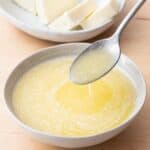How to Melt Butter
Learning how to melt butter is an essential kitchen skill that can be used for baking, cooking, and finishing dishes.
Servings: 8 tablespoons
Equipment
Ingredients
- 1 stick butter salted or unsalted
Instructions
Melting Butter on the Stovetop
- Place a small saucepan on the stovetop burner and set the heat to low.
- Cut the butter into smaller pieces and add to the saucepan. As the butter begins to melt, stir it with a wooden spoon or silicone spatula to help it melt evenly and prevent it from sticking to the pan.
- Stir until the butter has completely melted and has a smooth consistency about 3-5 minutes. then remove the saucepan from the heat. Use the melted butter as desired.
Melting Butter in the Microwave
- Cut the butter into smaller pieces and add to a microwave-safe bowl that's large enough to hold the butter.
- Place the bowl in the microwave and heat using 15 to 20-second intervals on a medium-low power setting if possible.
- After each interval, open the microwave and stir the butter with a spoon to help distribute the heat and ensure even melting. Repeat until the butter is completely melted and smooth. Use the melted butter as desired.
Notes
Storage: If you have leftover melted butter, you can refrigerate in a sealed container after cooling it to room temperature. Keep it in the fridge for up to a few weeks.
Tips:
Measure the butter before melting. Even though butter retains the same volume whether solid or melted, it is more convenient to measure it accurately before melting thanks to the measurement markers on butter packaging.
Go low and slow. If using a stovetop, keep the butter on low heat to prevent it from overheating, as this can lead to a burnt taste. Likewise, if your microwave has the option, use a low power setting to gently melt the butter.
Stir the butter frequently. Unevenly melted butter can cause unwanted chunks of butter in your recipe, so take the time and effort to stir often. Stirring is even more important if using the microwave in order to prevent hotspots and ensure a consistent, smooth texture.
Slightly cool your butter before adding it to the recipe. If the butter is too hot, it can inadvertently heat other ingredients in your recipe which can ruin the texture and taste.
Nutrition
Serving: 1tablespoon | Calories: 101kcal | Carbohydrates: 0.01g | Protein: 0.1g | Fat: 11g | Saturated Fat: 7g | Polyunsaturated Fat: 0.4g | Monounsaturated Fat: 3g | Trans Fat: 0.5g | Cholesterol: 30mg | Sodium: 91mg | Potassium: 3mg | Sugar: 0.01g | Vitamin A: 353IU | Calcium: 3mg | Iron: 0.003mg
QR code
Scan code to view the full recipe on your phone.
